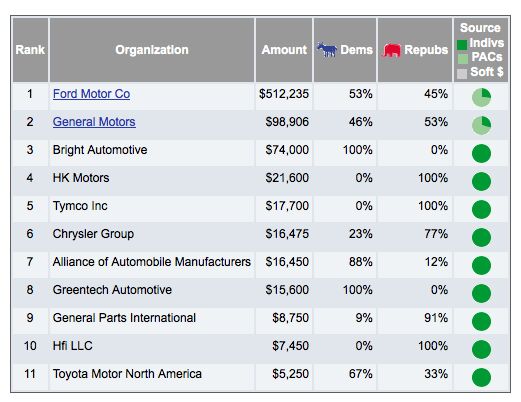The Auto Industry's Biggest Political Contributors Of The Midterm Election
With news reports filtering in about an industry-mounted offensives against the Motor Vehicle Safety Act and proposed increases to CAFE standards, we thought we’d take a look at how much the industry spent in the recent midterm election cycle. According to Opensecrets.org, the chart above shows the biggest spenders in “Automotive,” and industry sector that includes OEMs, suppliers, rental companies and just about anything else related to four-wheeled motorized transport. Charged up by the bailout-era dealer cull, it’s not surprising that NADA took the top spot, and with a hotly-contested Korea free trade agreement under negotiation, the AFIT PAC is a logical number two. But Enterprise beating out Ford? Didn’t see that one coming. Still, the contributor breakdown for the “Auto Manufacturer” sector is even more interesting…
The third-biggest OEM manufacturer is the Colorado-based manufacturer of a delivery van that it’s been shopping to the military. Number four is perhaps the most interesting: HK Motors is the Alabama-based prospective manufacturer of mysterious hybrid vehicles run by former Brilliance Chairman Yung Yueng. It’s also a Visa farm which uses the State Department’s EB-5 program… a scheme that closely resembles a venture being launched by Brilliance’s former CEO. And it outspent Chrysler in the latest election.
Still, the big lesson from these numbers is that the entire auto industry is spending way less on campaign contributions than in years past. No surprises there: the automakers have been cutting back everywhere for the last several years. But then campaign contributions are also just one part of the equation: lobbying on Capitol Hill is often a more effective tool for influencing policy. Below is a list of the top automaker lobbying spenders of 2010.
More by Edward Niedermeyer
Latest Car Reviews
Read moreLatest Product Reviews
Read moreRecent Comments
- Blope Cataluna Red Audi Etron and a Red Golf TDI Wagon
- Vulpine Considering the size of modern full-sized pickup, they NEED the ability to "squat" just to be able to load/unload them from the rear. It's a law that needs to be contested for the utility of the capability, despite the fact that... yes, it can be abused by show--offs.
- SCE to AUX I have two bright blue Hyundais at the moment, and I've only had one red car.I think I've had 7 white cars. My very first car was orange.A friend once said he buys the ugliest, or most garish color on the lot, to try and get a better price on a dealer dud. It also makes the car easier to spot in a sea of gray vehicles. I couldn't do that, but I see the logic.
- Bd2 For the medium to long term, not much as other automakers are building out their own charging network whether via the consortium or on their own (some, like Mercedes are doing both).
- ToolGuy Let's count the poor decisions: Honda 18 model years past peak Honda. Ohio. Following too closely ('rock on the highway' doesn't leap up and attack your vehicle by itself, it is riding on a vehicle or thrown up by a vehicle, and you should be alert to this). Ohio. Not enough doors. Choosing to expand family -- in Ohio. 😉 Also not great at math.Engine bay picture: At least take a shower before your glamour shot lol.





































Comments
Join the conversation
You left out the major contributor that gave more than all these organization combined--the UAW. Around $8.5 million in 2010 alone, and ALL to Democrats and Left-leaning causes. That doesn't count what the members individually contributed either. The UAW was THE reason for the auto bailouts. The rest of these numbers are chickenfeed. It was always about filling political coffers.
I was surprised to see my old employer JM Family Enterprises so high on the list. They are better known as Southeast Toyota Distributors. The founder Jim Moran was a big time democrat. After he died the company was turned over to some management group. When I was working there they ran an ad that showed a smiling mouth of pearly white teeth, except that one tooth was gold plated and had the Toyota sombrero painted on it. I suppose the persons mouth in the ad was black (I never saw the ad and I don't know what the copy was) because Jessie Jackson went ballistic on Southeast Toyota and did his usual race pimping. Somehow the ad was racist. Unfortunately JM capitulated to his complaints, apologized profusely, promised to never do it again, and committed to lots more diversity training (on top of what we already had). Somehow I don't think any of that was as important to Jessie as the big fat contribution that was given to his organization.